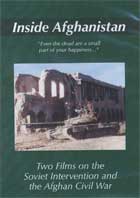
Inside Afghanistan: Two Films on the Soviet Intervention and the Afghan Civil War (The Black Tulip & Inside Afghanistan) 1988
Distributed by Ethnoscope Film & Video, PO Box 92353, Rochester, NY 14692; 585-442-5247
Produced by Pacho Lane
Directed by Pacho Lane
DVD, color, 26 min. & 56 min.
Sr. High - Adult
History, Middle Eastern Studies
Date Entered: 10/27/2006
Reviewed by Gloria Maxwell, Reference Librarian, Penn Valley Community College, Kansas City, MOInside Afghanistan, the DVD, is actually two films that were filmed in 1987. The first feature is The Black Tulip, which is the name given to the plane that carried Soviet soldiers’ bodies back home. This film documents how Soviet troops initially came at the request of the legal Afghan government, but not at the request of the people. Through interviews and commentaries by experts and historians, this feature shows how the poor are deceived by religious extremists. The guerillas are described as illiterates who are also inspired and led astray by the same zealotry. The guerillas are portrayed as drug addicts who get paid to kill Soviet soldiers—who get paid for everything they do. These images are contrasted by those of grieving Soviet families and comrades. Obelisks are created to honor their fallen soldiers and these memorials are visited by many. Soviet minesweepers work to remove as many mines as possible, to spare the Afghanis, as they fight the ever persistent guerillas. The Soviets say that the sacrifices made during World War II made sense, but that those in Afghanistan do not.
The second feature on this DVD, Inside Afghanistan, explores Soviet intervention following the 1978 coup that overthrew the Shah. Problems ensued between Soviet-educated modern Afghanis and Islamic militants. Continued Soviet intervention failed to solve the problems or improve the situation. This documentary features interviews with the poor—those who are not working with the government or the rebels—they are just poor. After the revolution, many Afghanis went to the Soviet Union to learn their language and more about their northern neighbor. What they found there was freedom, and friendship and advice from the Soviets. The film provides interviews with some of the Afghanis who became Russianized. Learning the Russian language is described as “enriching.” Russian schools are considered good, and Afghans want education, both men and women. After the revolution, equality between men and women, improved conditions, and education were all things that seemed possible. Now, they feel the enemy works with imperialists. Interviews with young men show that they are loyal to their commander—whether that commander works for the government or for the Mujahedin, or goes between the two. They will fight whomever he tells them to fight. Most see the Mujahedin as their friends, and believe that either the government in Afghanistan or the one in Pakistan is responsible for the bombs and imprisons their relatives. In chilling interviews, Afghanis say that the Mujahedin are “not sons of Englishmen, they are Muslims and holy warriors, only misled by enemy propaganda.” They think that America, England, Japan and Iran are responsible for the war in their country. They see English writing on the weapons and believe they are sent to Pakistan to be sold to their enemies. The Mujahedin believe they are right and the civilians are not afraid to fight their enemy. Among the more reasonable civilians interviewed come comments that they don’t want an Islamic Republic, nor do they want a Marxist government. They want the traditional autonomy of their villages, modernization, and neutrality between east and west. They want Afghans to quit killing other Afghans. From those voices comes the only hope for their future. As one man says, “Afghanistan is my life, my homeland, mother of us all. I don’t betray my country. I want to save it.”
Technical aspects are adequate.
This DVD would be an excellent addition to high school, public and academic library media collections. It provides an exceptional educational experience for classroom use and instruction.
Highly recommended.